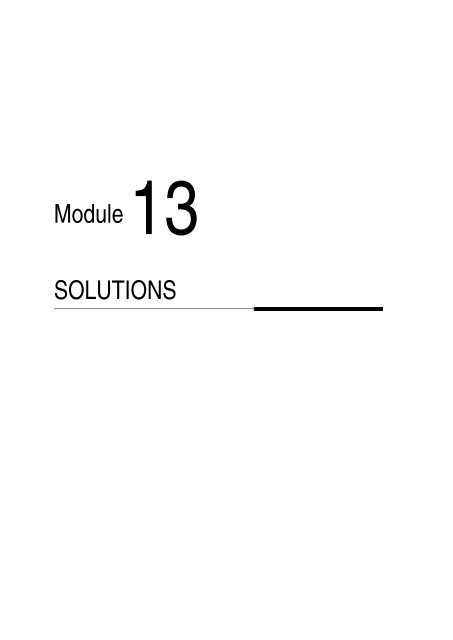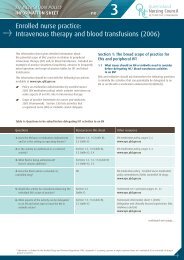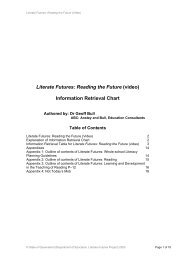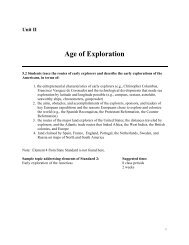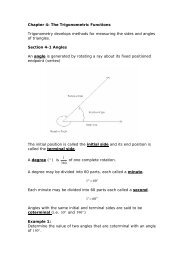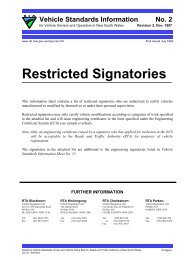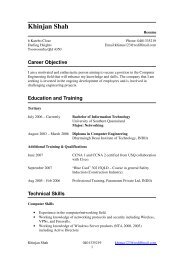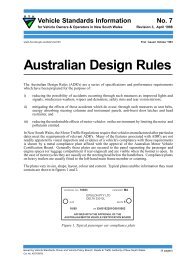USQ study material - Upload Student Web Pages
USQ study material - Upload Student Web Pages
USQ study material - Upload Student Web Pages
Create successful ePaper yourself
Turn your PDF publications into a flip-book with our unique Google optimized e-Paper software.
Module<br />
13<br />
SOLUTIONS
Module 13 – Solutions 13.1<br />
Introduction<br />
Note that the question numbers and chapter numbers are following the textbook not this <strong>study</strong><br />
book.<br />
13.1 Chapter 4 Relational Algebra and Relational Calculus<br />
Solutions and hints of some exercises<br />
For the following exercises, use the Hotel schema defined at the start of the Exercises at the end<br />
of Chapter 3.<br />
4.8 Describe the relations that would be produced by the following relational algebra operations:<br />
a) Π hotelNo (σ price > 50 (Room) )<br />
This will produce a relation with a single attribute (hotelNo) giving the number of those hotels<br />
with a room price greater than £50.<br />
b) σ Hotel.hotelNo = Room.hotelNo (Hotel × Room)<br />
This will produce a join of the Hotel and Room relations containing all the attributes of both Hotel<br />
and Room (there will be two copies of the hotelNo attribute). Essentially this will produce a relation<br />
containing all rooms at all hotels.<br />
c) Π hotelName (Hotel Hotel.hotelNo = Room.hotelNo (σ price > 50 (Room)) )<br />
This will produce a join of Hotel and those tuples of Room with a price greater than £50. Essentially<br />
this will produce a relation containing all hotel names with a room price above £50.<br />
d) Guest (σ dateTo ≥‘1-Jan-2002’ (Booking))<br />
This will produce a (left outer) join of Guest and those tuples of Booking with an end date (dateTo)<br />
greater than or equal to 1-Jan-2002. All guests who don’t have a booking with such a date will<br />
still be included in the join. Essentially this will produce a relation containing all guests and show<br />
the details of any bookings they have beyond 1-Jan-2002.<br />
e) Hotel Hotel.hotelNo = Room.hotelNo (σ price > 50 (Room)) )<br />
This will produce a (semi) join of Hotel and those tuples of Room with a price greater than £50.<br />
Only those Hotel attributes will be listed. Essentially this will produce a relation containing all<br />
the details of all hotels with a room price above £50.<br />
f) Π guestName, hotelNo (Booking Booking.guestNo = Guest.guestNo Guest) ÷ Π hotelNo (σ city = ’London’ (Hotel))<br />
This will produce a relation containing the names of all guest who have booked all hotels in London.
13.2 CSC3400 – Database systems<br />
4.9 Provide the equivalent tuple relational calculus and domain relational calculus expressions<br />
for each of the relational algebra queries given in Exercise 4.8.<br />
a) Π hotelNo (σ price > 50 (Room) )<br />
TRC: {R.hotelNo | Room(R) ∧ R.price > 50}<br />
DRC: {hotelNo | (∃rNo, typ, prce) (Room (rNo, hotelNo, typ, prce) ∧ prce > 50)}<br />
–<br />
b) σ Hotel.hotelNo = Room.hotelNo (Hotel × Room)<br />
TRC:<br />
DRC:<br />
{H, R | Hotel(H) ∧ (∃R) (Room(R) ∧ (H.hotelNo = R.hotelNo))}<br />
{hNo, hName, cty, rNo, hNo1, typ, prce | (Hotel(hNo, hName, cty) ∧ Room(rNo, hNo1,<br />
typ, prce) ∧ (hNo = hNo1))}<br />
–<br />
c) Π hotelName (Hotel Hotel.hotelNo = Room.hotelNo (σ price > 50 (Room)) )<br />
TRC: {H.hotelName | Hotel(H) ∧ (∃R) (Room(R) ∧ (H.hotelNo = R.hotelNo) ∧ (R.price ><br />
50))}<br />
DRC:<br />
{hotelName | (∃hNo, cty, rNo, hNo1, typ, prce) (Hotel(hNo, hotelName, cty) ∧<br />
Room(rNo, hNo1, typ, prce) ∧ (hNo = hNo1) ∧ (prce > 50))}<br />
–<br />
d) Guest (σ dateTo ≥‘1-Jan-2002’ (Booking))<br />
TRC:<br />
DRC:<br />
{G.guestNo, G.guestName, G.guestAddress, B.hotelNo, B.dateFrom, B.dateTo,<br />
B.roomNo | Guest(G) ∨ (∃B) (Booking(B) ∧ (G.guestNo = B.guestNo) ∧ (B.dateTo ><br />
‘1-Jan-2002’))}<br />
{guestNo, guestName, guestAddress, hotelNo, dateFrom, dateTo, roomNo | (∃gNo1)<br />
(Guest(guestNo, guestName, guestAddress) ∨ (Booking(hotelNo, gNo1, dateFrom,<br />
dateTo, roomNo) ∧ (guestNo = gNo1) ∧ (dateTo Š‘1-Jan-2002’)))}<br />
–<br />
e) Hotel Hotel.hotelNo = Room.hotelNo (σ price > 50 (Room)) )<br />
TRC:<br />
DRC:<br />
{H.hotelNo, H.hotelName, H.city | Hotel(H) ∧ (∃R) (Room(R) ∧ (H.hotelNo = R.hotelNo)<br />
∧ (R.price > 50))}<br />
{hotelNo, hotelName, city | (∃rNo, hNo1, typ, prce) (Hotel(hotelNo, hotelName, city)<br />
∧ Room(rNo, hNo1, typ, prce) ∧ (hotelNo = hNo1) ∧ (prce > 50))}<br />
–<br />
f) Π guestName, hotelNo (Booking Booking.guestNo = Guest.guestNo Guest) ÷ Π hotelNo (σ city = ’London’ (Hotel))
Module 13 – Solutions 13.3<br />
TRC:<br />
DRC:<br />
{G.guestName | Guest(G) ∧(∼ (∃H) (Hotel(H) ∧ (H.city = ‘London’) ∧ (∼(∃B)<br />
(Booking(B) ∧ G.guestNo = B.guestNo ∧ H.hotelNo = B.hotelNo))))}<br />
{guestName | (∃gNo, gName, gAddress, hNo, gNo1, dFrom, dTo, rNo, hName, cty,<br />
hNo1, typ, prce) (∼(Hotel(hNo, hName, cty) ∧ (cty = ‘London’) ∧ Guest(gNo, gName,<br />
gAddress) ∧ Booking(hNo1, gNo1, dFrom, dTo, rNo) ∧ (gNo = gNo1) ∧ (hNo = hNo1)))}<br />
–<br />
4.11 Provide the equivalent domain relational calculus and relational algebra expressions for<br />
each of the tuple relational calculus expressions given in Exercise 4.10.<br />
(a) {H.hotelName | Hotel(H) ∧ H.city = ‘London’}<br />
DRC:<br />
{hotelName | (∃hNo, cty) (Hotel(hNo, hotelName, cty) ∧ cty = ‘London’)}<br />
RA: Π hotelName (σ city = ‘London’ (Hotel) )<br />
–<br />
(b) {H.hotelName | Hotel(H) ∧ (∃R) (Room(R) ∧ H.hotelNo = R.hotelNo ∧ R.price > 50)}<br />
DRC:<br />
{hotelName | (∃hNo, cty, rNo, hNo1, typ, prce) (Hotel(hNo, hotelName, cty) ∧<br />
Room(rNo, hNo1, typ, prce) ∧ (hNo = hNo1) ∧ (prce > 50)) }<br />
RA: Π hotelName (Hotel Hotel.hotelNo = Room.hotelNo (σ price > 50 (Room)) ) ))}<br />
RA: Π hotelName (σ guestName = ‘John Smith’ (Guest) Guest.guestNo = guestNo ( Booking . Booking.hotelNo =<br />
Hotel.hotelNo Hotel))<br />
–<br />
(c) {H.hotelName, G.guestName, B1.dateFrom, B2.dateFrom | Hotel(H) ∧ Guest(G) ∧ Booking(B1)<br />
∧ Booking(B2) ∧ H.hotelNo = B1.hotelNo ∧ G.guestNo = B1.guestNo ∧ B2.hotelNo = B1.hotelNo<br />
∧ B2.guestNo = B1.guestNo ∧ B2.dateFrom ≠ B1.dateFrom}<br />
DRC:<br />
RA:<br />
{hotelName, guestName, dateFrom1, dateFrom2 | (∃hNo, cty, gNo, gAddress, hNo1,<br />
gNo1, dTo1, rNo1, hNo2, gNo2, dTo2, rNo2) (Hotel(hNo, hotelName, cty) ∧ Guest(gNo,<br />
guestName, gAddress) ∧ Booking(hNo1, gNo1, dateFrom1, dTo1, rNo1) ∧<br />
Booking(hNo2, gNo2, dateFrom2, dTo2, rNo2) ∧ (hNo = hNo1) ∧ (gNo = gNo1) ∧<br />
(hNo2 = hNo1) ∧ (gNo2 = gNo1) ∧ (dateFrom1 ≠ dateFrom2))}<br />
Booking2(hotelNo, guestNo, dateFrom2, dateTo2, roomNo2) ←Π hotelNo, guestNo, dateFrom,<br />
dateTo, roomNo (Booking) Π hotelName, guestName, dateFrom, dateFrom2 (Hotel Hotel.hotelNo = hotelNo (Guest<br />
Guest.guestNo = guestNo. (Booking Booking.hotelNo = Booking2.hotelNo ∧ Booking.guestNo = Booking2.guestNo ∧<br />
dateFrom ≠ dateFrom2 Booking2)))<br />
–<br />
4.12 Generate the relational algebra, tuple relational calculus, and domain relational calculus<br />
expressions for the following queries:<br />
(a) List all hotels.
13.4 CSC3400 – Database systems<br />
RA:<br />
TRC:<br />
DRC:<br />
Hotel<br />
{H | Hotel(H)}<br />
{hotelNo, hotelName, city | Hotel(hotelNo, hotelName, city)}<br />
–<br />
(b) List all single rooms with a price below £20 per night.<br />
RA:<br />
σ type=‘S’∧ price < 20 (Room)<br />
TRC: {R | Room(R) ∧ R.type = ‘S’∧ R.price < 20}<br />
DRC:<br />
{roomNo, hotelNo, type, price | (Room(roomNo, hotelNo, type, price) ∧ type = ‘S’∧<br />
price < 20)}<br />
–<br />
(c) List the names and cities of all guests.<br />
RA:<br />
TRC:<br />
DRC:<br />
Π guestName, guestAddress (Guest)<br />
{G.guestName, G.guestAddress | Guest(G)}<br />
{guestName, guestAddress | (∃guestNo) (Guest(guestNo, guestName, guestAddress))}<br />
–<br />
(d) List the price and type of all rooms at the Grosvenor Hotel.<br />
RA:<br />
TRC:<br />
DRC:<br />
Π price, type (Room hotelNo (σ hotelName = ‘Grosvenor Hotel’ (Hotel)))<br />
{R.price, R.type | Room(R) ∧ (∃H) (Hotel(H) ∧.(R.hotelNo = H.hotelNo) ∧ (H.hotelName<br />
= ‘Grosvenor Hotel’))}<br />
{price, type | (∃roomNo, hotelNo, hotelNo1, hotelName, city) (Room(roomNo, hotelNo,<br />
type, price) ∧ Hotel(hotelNo1, hotelName, city) ∧ (hotelNo = hotelNo1) ∧ (hotelName<br />
= ‘Grosvenor Hotel’))}<br />
–<br />
4.13 Π roomNo, hotelNo, type (Room hotelNo (σ hotelName=‘Grosvenor Hotel’ (Hotel)))<br />
Security – hides the price details from people who should not see it.<br />
Reduced complexity – a query against this view is simpler than a query against the two underlying<br />
base relations.<br />
13.2 Chapter 5 SQL: Data Manipulation<br />
Solutions and hints of some exercises<br />
Simple Queries
Module 13 – Solutions 13.5<br />
5.9 SELECT guestName, guestAddress FROM Guest<br />
WHERE address LIKE ‘%London%’ ORDER BY guestName;<br />
Strictly speaking, this would also find rows with an address like: ‘10 London Avenue,<br />
New York’.<br />
5.10 SELECT * FROM Room WHERE price < 40 AND type IN (‘D’, ‘F’)<br />
ORDER BY price;<br />
(Note, ASC is the default setting).<br />
5.11 SELECT * FROM Booking WHERE dateTo IS NULL;<br />
–<br />
Aggregate Functions<br />
5.12 SELECT COUNT(*) FROM Hotel;<br />
5.13 SELECT AVG(price) FROM Room;<br />
5.15 SELECT COUNT(DISTINCT guestNo) FROM Booking<br />
WHERE (dateFrom = DATE’2001-08-01’)<br />
OR (dateFrom >= DATE’2001-08-01’ AND dateFrom
13.6 CSC3400 – Database systems<br />
5.21 SELECT SUM(price)<br />
FROM Room r<br />
WHERE roomNo NOT IN<br />
(SELECT roomNo FROM Booking b, Hotel h<br />
WHERE (dateFrom = CURRENT_DATE) AND<br />
b.hotelNo = h.hotelNo AND hotelName = ‘Grosvenor Hotel’);<br />
–<br />
Grouping<br />
5.22 SELECT hotelNo, COUNT(roomNo) AS count FROM Room GROUP BY hotelNo;<br />
5.24 SELECT AVG(X)<br />
FROM (SELECT hotelNo, COUNT(hotelNo) AS X<br />
FROM Booking b<br />
WHERE (dateFrom = DATE’2001-08-01’) OR<br />
(dateFrom >= DATE’2001-08-01’ AND<br />
dateFrom
Module 13 – Solutions 13.7<br />
5.31 Show that SQL is relationally complete.<br />
Hint: Allow the students to show that each of the relational algebra operations can be<br />
expressed in SQL.<br />
–<br />
13.3 Chapter 6 SQL: Data Definition<br />
Solutions and hints of some exercises<br />
6.7 CREATE TABLE Hotel(<br />
hotelNo CHAR(4) NOT NULL,<br />
hotelName VARCHAR(20) NOT NULL,<br />
city VARCHAR(50) NOT NULL,<br />
PRIMARY KEY (hotelNo));<br />
Or<br />
CREATE DOMAIN HotelNumber AS CHAR(4);<br />
CREATE TABLE Hotel(<br />
hotelNo HotelNumber NOT NULL,<br />
hotelName VARCHAR(20) NOT NULL,<br />
city VARCHAR(50) NOT NULL,<br />
PRIMARY KEY (hotelNo));<br />
6.8 Now create the Room, Booking, and Guest tables using the integrity enhancement<br />
features of SQL with the following constraints:<br />
(a) Type must be one of Single, Double, or Family.<br />
(b) Price must be between £10 and £100.<br />
(c) roomNo must be between 1 and 100.<br />
(d) dateFrom and dateTo must be greater than today’s date.<br />
(e) The same room cannot be double booked.<br />
(f)<br />
The same guest cannot have overlapping bookings.
13.8 CSC3400 – Database systems<br />
CREATE TABLE Room(<br />
roomNo VARCHAR(4) NOT NULL<br />
CHECK(VALUE BETWEEN ‘1’ AND ‘100’),<br />
hotelNo CHAR(4) NOT NULL<br />
CHECK(VALUE IN (SELECT hotelNo FROM Hotel)),<br />
type CHAR(1) NOT NULL DEFAULT ‘S’<br />
CHECK(VALUE IN (‘S’, ‘F’, ‘D’)),<br />
price<br />
NUMERIC(5, 2) NOT NULL<br />
CHECK(VALUE BETWEEN 10 AND 100),<br />
PRIMARY KEY (roomNo, hotelNo),<br />
FOREIGN KEY (hotelNo) REFERENCES Hotel<br />
ON DELETE CASCADE ON UPDATE CASCADE);<br />
CREATE TABLE Guest(<br />
guestNo CHAR(4) NOT NULL,<br />
guestName VARCHAR(20) NOT NULL,<br />
guestAddress VARCHAR(50) NOT NULL);<br />
CREATE TABLE Booking(<br />
hotelNo CHAR(4) NOT NULL<br />
CHECK(VALUE IN (SELECT hotelNo FROM Hotel)),<br />
guestNo CHAR(4) NOT NULL,<br />
dateFrom DATETIME NOT NULL<br />
CHECK(VALUE > CURRENT_DATE),<br />
dateTo DATETIME NULL<br />
CHECK(VALUE > CURRENT_DATE),<br />
roomNo<br />
VARCHAR(4) NOT NULL<br />
CHECK(VALUE BETWEEN ‘1’ AND ‘100’),<br />
PRIMARY KEY (hotelNo, guestNo, dateFrom),<br />
FOREIGN KEY (hotelNo) REFERENCES Hotel<br />
ON DELETE CASCADE ON UPDATE CASCADE,<br />
FOREIGN KEY (guestNo) REFERENCES Guest<br />
ON DELETE NO ACTION ON UPDATE CASCADE,<br />
FOREIGN KEY (hotelNo, roomNo) REFERENCES Room<br />
ON DELETE NO ACTION ON UPDATE CASCADE,<br />
CONSTRAINT RoomBooked CHECK (NOT EXISTS (<br />
SELECT * FROM Booking b<br />
WHERE b.dateTo > Booking.dateFrom AND<br />
b.dateFrom < Booking.dateTo AND<br />
b.roomNo = Booking.roomNo AND<br />
b.hotelNo = Booking.hotelNo)),<br />
CONSTRAINT GuestBooked CHECK (NOT EXISTS (<br />
SELECT * FROM Booking b<br />
WHERE b.dateTo > Booking.dateFrom AND<br />
b.dateFrom < Booking.dateTo AND<br />
b.guestNo = Booking.guestNo)));<br />
Or
Module 13 – Solutions 13.9<br />
CREATE DOMAIN RoomType AS CHAR(1)<br />
CHECK(VALUE IN (‘S’, ‘F’, ‘D’));<br />
CREATE DOMAIN HotelNumbers AS HotelNumber<br />
CHECK(VALUE IN (SELECT hotelNo FROM Hotel));<br />
CREATE DOMAIN RoomPrice AS DECIMAL(5, 2)<br />
CHECK(VALUE BETWEEN 10 AND 100);<br />
CREATE DOMAIN RoomNumber AS VARCHAR(4)<br />
CHECK(VALUE BETWEEN ‘1’ AND ‘100’);<br />
CREATE TABLE Room(<br />
roomNo RoomNumber NOT NULL,<br />
hotelNo HotelNumbers NOT NULL,<br />
type RoomType NOT NULL DEFAULT ‘S’,<br />
price RoomPrice NOT NULL,<br />
PRIMARY KEY (roomNo, hotelNo),<br />
FOREIGN KEY (hotelNo) REFERENCES Hotel<br />
ON DELETE CASCADE ON UPDATE CASCADE);<br />
CREATE DOMAIN GuestNumber AS CHAR(4);<br />
CREATE TABLE Guest(<br />
guestNo GuestNumber NOT NULL,<br />
guestName VARCHAR(20) NOT NULL,<br />
guestAddress VARCHAR(50) NOT NULL);<br />
CREATE DOMAIN GuestNumbers AS GuestNumber<br />
CHECK(VALUE IN (SELECT guestNo FROM Guest));<br />
CREATE DOMAIN BookingDate AS DATETIME<br />
CHECK(VALUE > CURRENT_DATE);
13.10 CSC3400 – Database systems<br />
CREATE TABLE Booking(<br />
hotelNo HotelNumbers NOT NULL,<br />
guestNo GuestNumbers NOT NULL,<br />
dateFrom BookingDate NOT NULL,<br />
dateTo BookingDate NULL,<br />
roomNo RoomNumber NOT NULL,<br />
PRIMARY KEY (hotelNo, guestNo, dateFrom),<br />
FOREIGN KEY (hotelNo) REFERENCES Hotel<br />
ON DELETE CASCADE ON UPDATE CASCADE,<br />
FOREIGN KEY (guestNo) REFERENCES Guest<br />
ON DELETE NO ACTION ON UPDATE CASCADE,<br />
FOREIGN KEY (hotelNo, roomNo) REFERENCES Room<br />
ON DELETE NO ACTION ON UPDATE CASCADE,<br />
CONSTRAINT RoomBooked CHECK (NOT EXISTS (<br />
SELECT * FROM Booking b<br />
WHERE b.dateTo > Booking.dateFrom AND<br />
b.dateFrom < Booking.dateTo AND<br />
b.roomNo = Booking.roomNo AND<br />
b.hotelNo = Booking.hotelNo)),<br />
CONSTRAINT GuestBooked CHECK (NOT EXISTS (<br />
SELECT * FROM Booking b<br />
WHERE b.dateTo > Booking.dateFrom AND<br />
b.dateFrom < Booking.dateTo AND<br />
b.guestNo = Booking.guestNo)));<br />
6.11 CREATE VIEW BookingOutToday AS<br />
SELECT g.guestNo,g.guestName,g.guestAddress,r.price*(b.dateTo- b.dateFrom)<br />
FROM Guest g, Booking b, Hotel h, Room r<br />
WHERE g.guestNo = b.guestNo AND<br />
r.roomNo = b.roomNo AND<br />
b.hotelNo = h.hotelNo AND<br />
h.hotelName = ‘Grosvenor Hotel’ AND<br />
b.dateTo = CURRENT_DATE;<br />
6.13 GRANT SELECT ON HotelData TO Accounts;<br />
GRANT SELECT ON BookingOutToday TO Accounts;<br />
General<br />
REVOKE SELECT ON HotelData FROM Accounts;<br />
REVOKE SELECT ON BookingOutToday FROM Accounts;<br />
6.15 Consider the following table:Part (partNo, contract, partCost) which<br />
represents the cost negotiated under each contract for a part (a part may have a different<br />
price under each contract).<br />
Now consider the following view ExpensiveParts, which contains the distinct part<br />
numbers for parts that cost more than £1000:
Module 13 – Solutions 13.11<br />
CREATE VIEW ExpensiveParts (partNo)<br />
AS SELECT DISTINCT partNo<br />
FROM Part<br />
WHERE partCost > 1000;<br />
Discuss how you would maintain this as a <strong>material</strong>ized view and under what<br />
circumstances you would be able to maintain the view without having to access the<br />
underlying base table Part.<br />
If a row is inserted into Part with a partCost less than or equal to £1000, the view would<br />
not have to be updated. If a partNo is inserted into Part that is already in the view, no<br />
new record has to be inserted into the view (because of the DISTINCT keyword).<br />
Similarly for update. If a partNo is deleted from Part have to access the underlying base<br />
table to check if there is another partNo with same value, to determine whether row<br />
should be deleted from the view.<br />
–<br />
13.4 Chapter 9 Database Planning, Design, and<br />
Administration<br />
Solutions and hints of some exercises<br />
9.14 The student should follow the approach to DBMS selection described in Section 9.7<br />
and produce a report that identifies a suitable DBMS product that meets the requirements<br />
of the organization. The selection should be fully justified and any assumptions made<br />
should be highlighted.<br />
9.15 The student should follow the approach to DBMS selection described in Section 9.7<br />
and produce a report that identifies a suitable DBMS product that meets the requirements<br />
of each organization described in Appendix B. The selection should be fully justified<br />
and any assumptions made about the case <strong>study</strong> should be highlighted.<br />
9.16 The student should investigate the organization and identify whether data administration<br />
and database administration exist as distinct functional areas. However, the student<br />
should be careful to note that these functions may be named differently, merged as a<br />
single function, or included as part of a larger IT/IS function. If identified, the student<br />
should compile a report documenting the organization, responsibilities, and tasks.<br />
–<br />
13.5 Chapter 10 Fact-Finding Techniques<br />
Solutions and hints of some exercises
13.12 CSC3400 – Database systems<br />
10.10 The student could come at this from two directions: first, these are case studies and<br />
individuals within the organizations cannot be met or interviewed; second approach is<br />
more open, and the student assumes these are real organizations and staff can be<br />
interviewed, if necessary. This may involve some form of role play to help the student<br />
perform interviews and clarifythe requirements or elicit additional information.<br />
–<br />
13.6 Chapter 11 Entity-Relationship Modeling<br />
Solutions and hints of some exercises
Module 13 – Solutions 13.13<br />
11.10 Create an ER diagram for each of the following descriptions:<br />
(a) Each company operates four departments, and each department belongs to one<br />
company.<br />
(b) Each department in part (a) employs one or more employees, and each employee<br />
works for one department.<br />
(c) Each of the employees in part (b) may or may not have one or more dependants,<br />
and each dependant belongs to one employee.<br />
(d) Each employee in part (c) may or may not have an employment history.<br />
(e) Represent all the ER diagrams described in (a), (b), (c), and (d) as a single ER<br />
diagram.
13.14 CSC3400 – Database systems<br />
11.12<br />
–<br />
13.7 Chapter 12 Enhanced Entity-Relationship Modeling<br />
Solutions and hints of some exercises<br />
12.10 Could consider Manager as a specialization of the Staff entity. This would move the<br />
Manages relationship from Staff to the Manager subclass. However, the attributes for<br />
both entities would be the same and there would, therefore, seem to be no obvious<br />
advantage to introducing the Manager specialization.<br />
–<br />
13.8 Chapter 13 Normalization<br />
Exercises
Module 13 – Solutions 13.15<br />
13.16 (a) Identify the functional dependencies represented by the data shown in the form in<br />
Figure 13.25.<br />
Patient No → Full Name<br />
Ward No → Ward Name<br />
Drug No → Name, Description, Dosage, Method of Admin<br />
Patient No, Drug No, Start Date → Units per Day, Finish date<br />
The functional dependencies for Bed No are unclear. If Bed No was a unique number<br />
for the entire hospital, then could say that Bed No → Ward No. However, from<br />
further examination of the requirements specification, we can observe that Bed No<br />
is to do with the allocation of patients on the waiting list to beds.<br />
(b) Describe and illustrate the process of normalizing the data shown in Figure 13.25<br />
to first (1NF), second (2NF), third (3NF), and BCNF.<br />
First Normal Form<br />
Second Normal Form<br />
Third Normal Form/BCNF<br />
(c) Identify the primary, alternate, and foreign keys in your BCNF relations.<br />
Primary keys underlined.
13.16 CSC3400 – Database systems<br />
13.18 The student should state any assumptions made about the data shown in the table. For<br />
example, we may assume that a hotel may be associated with one or more contracts.<br />
The following is only a diagrammatic illustration of the solution, but in your assignment<br />
you need to give more details, for example, function dependencies and explanation.
Module 13 – Solutions 13.17<br />
13.19 (a) Describe why the relation shown in Figure 13.28 is in BCNF and not in 4NF.<br />
wardName ——»» staffName<br />
wardName ——»» patientName<br />
Relation is in BCNF but there is a nontrivial multi-valued dependency in the relation,<br />
so relation is not in 4NF.<br />
(b) The relation shown in Figure 13.28 is susceptible to update anomalies. Provide<br />
examples of insertion, deletion, and update anomalies.<br />
If we wanted to insert a new patient name, would have to add two records, one for<br />
each member of staff.<br />
If we wanted to update the name of patient Claire Johnson, we would have to update<br />
two records.<br />
If we wanted to delete the record corresponding to patient Claire Johnson, we would<br />
have to delete two records.<br />
(c) Describe and illustrate the process of normalizing the relation shown in Figure<br />
13.28 to 4NF.<br />
To remove the MVD, we create two new relations:<br />
WardStaff (wardName, staffName) WardPatient(wardName, patientName)<br />
13.20 (a) Describe why the relation shown in Figure 13.29 is not in 5NF.<br />
This relation has a join dependency JD(hospitalName, itemDescription, supplierNo)<br />
among the three projections: R1(hospitalName, itemDescription), R2(hospitalName,<br />
supplierNo), and R3(itemDescription, supplierNo) of HospitalItemSupplier.<br />
(b) Describe and illustrate the process of normalizing the relation shown in Figure<br />
13.29 to 5NF.<br />
To remove the join dependency, we create the following 5NF relations:<br />
HospitalItem(hospitalName, itemDescription) HospitalSupplier(hospitalName,<br />
supplierNo) ItemSupplier(itemDescription, supplierNo).<br />
–
13.18 CSC3400 – Database systems


